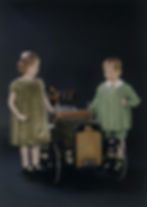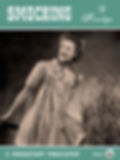The History of Smocking
- Lisa Hawkes
- Feb 9, 2018
- 6 min read
Updated: Jun 28, 2022

As I have interacted with many of you I have realized that a series on the basics of smocking might be helpful, so this is the first of several posts to explain a little about the art of smocking, the terminology and how to get started! Lets start with where smocking comes from - its history. Below is a video if you prefer to listen, or you can read all the details.
Smocking is essentially embroidery on pleated fabric. The art form that we traditionally think of as Smocking is primarily from The United Kingdom, is specifically known as English Smocking, and has been practiced in its current form for over 300 years. However, some form of stitching on pleated fabric, or smocking, can be seen all over Europe in paintings as old as the 1400s. Garments during this time were simply cut, and pleating or gathering was used to shape the garment and control the fullness of the fabric. Various forms of embroidery were then used to hold the pleating and provide a form of decoration. The resulting pleating could be elastic or non-elastic depending on the construction method chosen.
This painting from the early 14oos in the Netherlands shows honeycomb smocking at the hips of the Virgin. The smocking controls the fabric and provides the extra fullness needed for over the hips.
The actual term "smocking" comes from the name of an English garment, the smock, worn by both women and men. Some histories trace the garment back to the Anglo Saxon tunic. The Luttrell Psalter (circa 1340) shows a man ploughing who is wearing a tunic smock, and Chaucer describes a woman wearing a smock in the Miller's Tale in 1386. Shakespeare also references the smock in several of his plays.
Language is always changing and up until the 18th century, the word "smock" referred to a women's undergarment. Men wore "shirts" and a full skirted coat known as a "frock". By the end of the 1700's men were wearing a new form of garment with decoration, known as a smock-frock or smock.
Throughout the 1800s smocks were the standard dress for men and boys in rural Southern England and parts of Wales. The smock frock was an outer garment and was cut very full with the smocking used to control the fullness of the fabric.
Men would hopefully have 2, one for work and one for good. But the records of churches in the area show that they had smocks on hand to provide the men if needed. Cottage industries existed in several areas of England to supply these frocks. The technique of embroidering on the pleats was referred to as "biassing", "gauging" "plaiting" and by 1880, "smocking'. The smocks were made of a tough material, usually linen, and were often waxed. The Workwoman's Guide describes the smock as "made of strong linen...and the biassing (smocking) upon it is worked with the strongest glazed thread or cotton that can be procured...The shoulders and wrists as well as the back are biassed with strong, glazed thread in various patterns..." Numerous references in english literature, (including Thomas Hardy in Far From the Madding Crowd) and paintings from the time refer to these garments,
In this painting called Snowballing by John Morgan from 1865, the two boys in the center of the picture are wearing smocks rolled up and tucked in their pants so they can more easily move during the fight! By the end of the 1800s the popularity of the smock as a practical garment for country men was declining, Gertrude Jekyll wrote in Old West Surrey (1904) that "The old carter's smock-frock or round frock, still lingering, but on its way to becoming extinct...no better thing has ever been devised for any kind of outdoor wear that admits of the use of an outer garment. It turns an astonishing amount of wet."
Just as the smock was loosing favor as an outer garment for men, women's fashion was to come to the rescue! At the same time, women's fashion was rejecting the corset, primarily for health reasons, and embracing a looser, flowing style of dress. Smocking worked perfectly to help control the fullness!
Liberty, which was founded in 1875, began to offer a dressmaking service and its 1894 fashion catalog showed several designs that included smocking.` In 1887, Weldon's published the first of four books on Practical Smocking stating: "When the rage for artistic dressing set in a few years ago, smocking was revived and brought into requisition for the ornamentation of ladies and children's summer costumes, for lawn-tennis dresses and holland blouses; and so greatly has it increased in favour that it is now a recognized style of fashionable dress." Inspired by the Kate Greenaway dresses, Liberty followed up with a catalog called "Artistic Dress for Children."

Smocking continued to be fashionable in the early twentieth century and the Butterick Pattern Company mentions it in a booklet published in 1902.

Captured Unawares, Caroline Paterson
With WWI styles changed and while smocking was still depicted, the styles were now simpler, and the Liberty 1916 catalog showed smocking used in working garments and children's clothes. By 1924, Mrs. J.D. Rolleston, states in The Embroideress, that smocking was applied "almost exclusively to garments worn by artists and children, the agricultural laborer and the shepherd having abandoned their beautiful smocks altogether, but they have left us a legacy of which we should be proud and which should form the basis and inspiration of all our modern smocking."

Children's outfits from 1930-35 V & A Museum
Smocking on women's blouses and children's outfits was extremely popular in the 1920s and 30s, again with Liberty leading the way. According to the Book of Smocking by Diana Keay, "it was the ambition of every mother to dress her daughter in a tana lawn dress with rich deep smocking."
Smocking continued to be popular in the 40s and 50s. In the 1950s factories making children's clothes sent the dresses out to workers to be smocked by hand. In 1956 Read introduced is Smock Gathering Machine which gathered 16 rows at once, and the chore of gathering the fabric into pleats could now be done by machine! Iron on smocking dots were offered with patterns for those who did not or could not own a pleater or "smock gathering machine." Instructions also explained that the sewing machine could be used to "mark" the fabric by running long basting stitches that all started in the same place, remove the basting and use the resulting holes in the fabric as marks to gather up the pleats. Smocking was taught by The National Federation of Women's Institutes in England, and The Chella Thornton Smocking Book was published in 1951 in both the United Kingdom and Canada.

Penelope produced two pamphlets, and Grace Knott published English Smocking in 1962 in Canada.

In the 1970s artists discovered smocking and its textural qualities and started to use it in artistic designs apart from clothing. The Smocking Arts Guild of America was formed in 1979 in the United States to help preserve and foster the art of smocking, and smocking continued to be popular through the 70s and 80s. Smocking has always been connected to clothing and therefore in most situations to execute a smocking design, one needs to know how to sew and construct a garment. With the limitation, and then removal of sewing as a curriculum from most schools, smocking has not been as popular now in the 21st century. For those of us who love this art and want to continue to see it thrive, we face the difficulty of helping those who wish to learn, not only how to smock but also how to sew! It is my hope with a renewed interest in handmade items and a rejection of uniform, mass produced clothing, that there will be a renewed interest in smocking. The internet has raised new possibilities, making this art form accessible to those who want to learn how to smock, and hopefully will carry on the tradition. It is the goal of Pink Hollybush to help and encourage those who want to try this lovely form of stitching, to be successful in doing so! If you would like to learn how to smock, sign up for our Get Started Smocking Series and check out our Learn to Smock Course!
References: The Book of Smocking by Diana Keay; Smocking Traditional & Modern approaches by OEnone Cae and Jean Hodges; The Chella Thornton Smocking Book by Chella Thornton; Weldon's Practical Needlework, Smocking; and How to Do English Smocking by Grace Knott.






